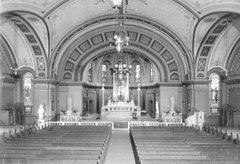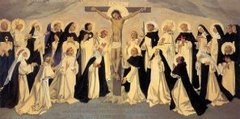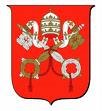Boise's own Peter Simon visited St. Dominic's Basilica in Bologna, Italy. He attended the August Chapter meeting and presented pictures he took, along with a brief presentation. Following are his pictures, and below that his written presentation.
Thank you Peter, well done!
Bologna, Italy.
Front of St. Dominic Basilica.
Exterior of St. Dominic Basilica.
Exterior of St. Dominic Basilica.
Exterior of St. Dominic Basilica.
High altar of St. Dominic Basilica. Note the white interior - "Lily of Purity."
Another view.
Mysteries of the Rosary side altar
Sacred Heart side altar
Mysteries of the Rosary
Tomb of St. Dominic/altar & ceiling
Ceiling above tomb
Tomb/altar. Carving by MichaelAngelo
Reliquary containing head of St Dominic located behind tomb
Photos in original church during visit of John Paul II. Basilica is built over original church which is preserved within and accessed from main church
In original church are various relics and items of historical note:
Bull of canonization of St. Dominic, bearing papal seal
Page from St. Dominic's breviary(?)
Papal bull establishing the Order of Preachers
table (altar?) on which miracle of loaves occurred. plus two unidentified relics in case.
St. Dominic
That Dominic and his companions might possess a fixed source of revenue Foulques made him chaplain of Fanjeaux and in July, 1215, canonically established the community as a religious congregation of his diocese, whose mission was the propagation of true doctrine and good morals, and the extirpation of heresy. During this same year Pierre Seilan, a wealthy citizen of Toulouse, who had placed himself under the direction of Saint Dominic, put at their disposal his own commodious dwelling. In this way the first convent of the Order of Preachers was founded on 25 April, 1215.
In November, 1215, an ecumenical council was to meet at Rome (The Fourth Lateran Council) "to deliberate on the improvement of morals, the extinction of heresy, and the strengthening of the faith". This was identically the mission Saint Dominic had determined on for his order. With the Bishop of Toulouse, he was present at the deliberations of this council. From the very first session it seemed that events conspired to bring his plans to a successful issue. The council bitterly arraigned the bishops for their neglect of preaching. In canon X they were directed to delegate capable men to preach the word of God to the people. Under these circumstances, it would reasonably appear that Dominic's request for confirmation of an order designed to carry out the mandates of the council would be joyfully granted.
Returning to Languedoc at the close of the council in December, 1215, the founder gathered about him his little band of followers and informed them of the wish of the council that there should be no new rules for religious orders. This done, Saint Dominic again appeared before the pope in the month of August, 1216, and again solicited the confirmation of his order. This time he was received more favourably, and on 22 December, 1216, the Bull of confirmation was issued. (St. Dominic arrived at Rome with a copy of his rules in September, 1216. He found access to his Holiness difficult for some time but was encouraged by a vision recorded by Theodoric, and copied by Fleury. * Pope Honorius III confirmed his Order and its constitutions by two bulls, both dated on the 26th of December, the same year.)
St. Dominic went again to Rome in 1217 and the Pope desiring that his Order should have a house in that city, gave him the church of St. Sixtus.
On his return to Rome, towards the end of December of 1219, Dominic sent out letters to all the convents announcing the first general chapter of the order, to be held at Bologna on the feast of the following Pentecost. In December of 1219 Pope Honorius III, by a special Brief , had conferred upon the founder the title of Master General, which till then he had held only by tacit consent.
Towards the end of 1221 Saint Dominic returned to Rome for the sixth and last time. Here he received many new and valuable concessions for the order. In January, February, and March of 1221 three consecutive Bulls were issued commending the order to all the prelates of the Church. The thirtieth of May, 1221, found him again at Bologna presiding over the second general chapter of the order. At the close of the chapter he set out for Venice to visit Cardinal Ugolino, to whom he was especially indebted for many substantial acts of kindness. He had scarcely returned to Bologna when a fatal illness attacked him. He died after three weeks of sickness, the many trials of which he bore with heroic patience. In a Bull dated at Spoleto, 13 July, 1234, Gregory IX made his cult obligatory throughout the Church. On August 6, 1221, Dominic died, only fifty-one years old.
We are not surprised, therefore, that, after signing the Bull of canonization on 13 July, 1234, Pope Gregory IX declared that he no more doubted the saintliness of Saint Dominic than he did that of Saint Peter and Saint Paul.










































High altar of St. Dominic Basilica. Note the white interior - "Lily of Purity."
ReplyDeleteAnd Ivory of Chastity!
That was indeed an excellent presentation.
Thank you. I enjoy this post, very much.
ReplyDelete